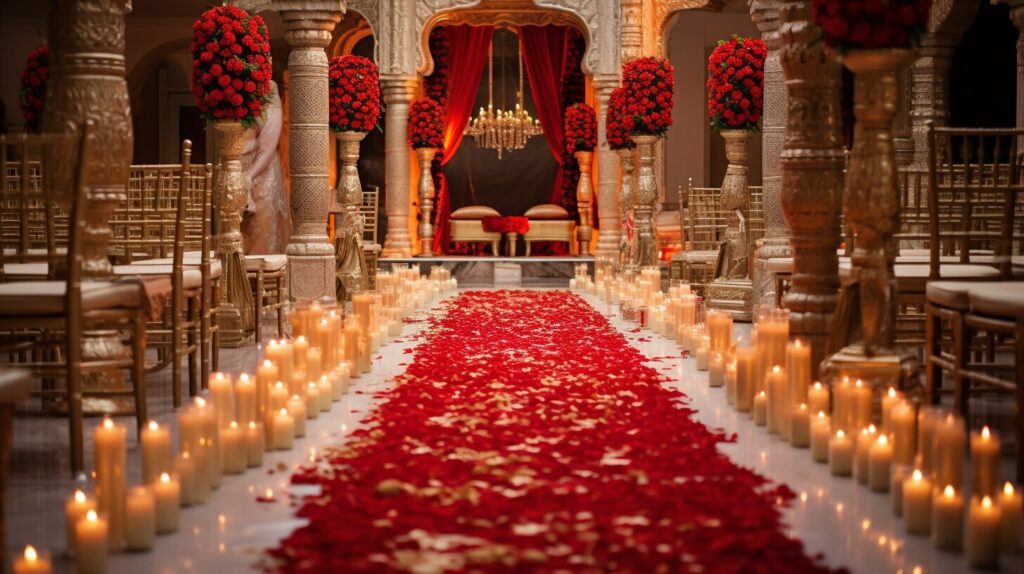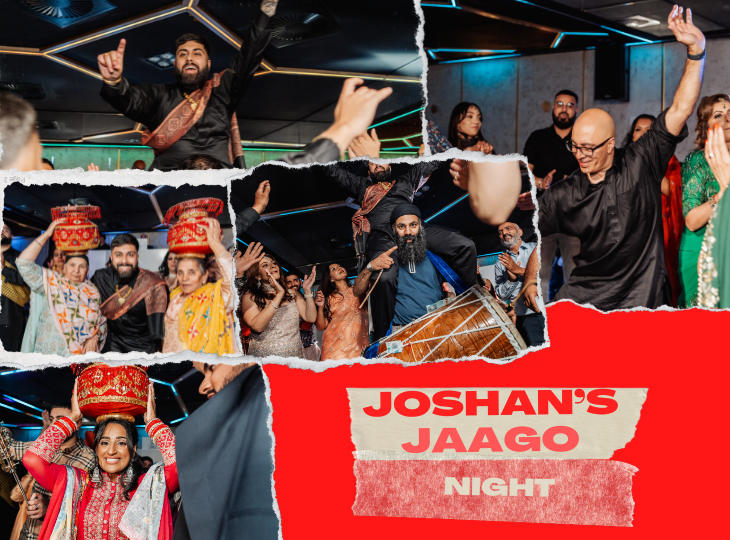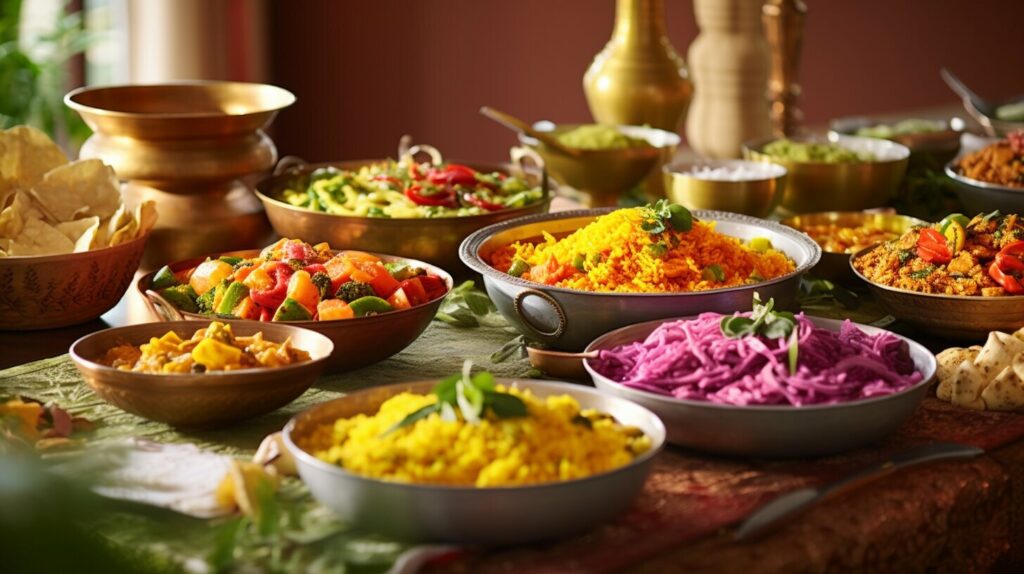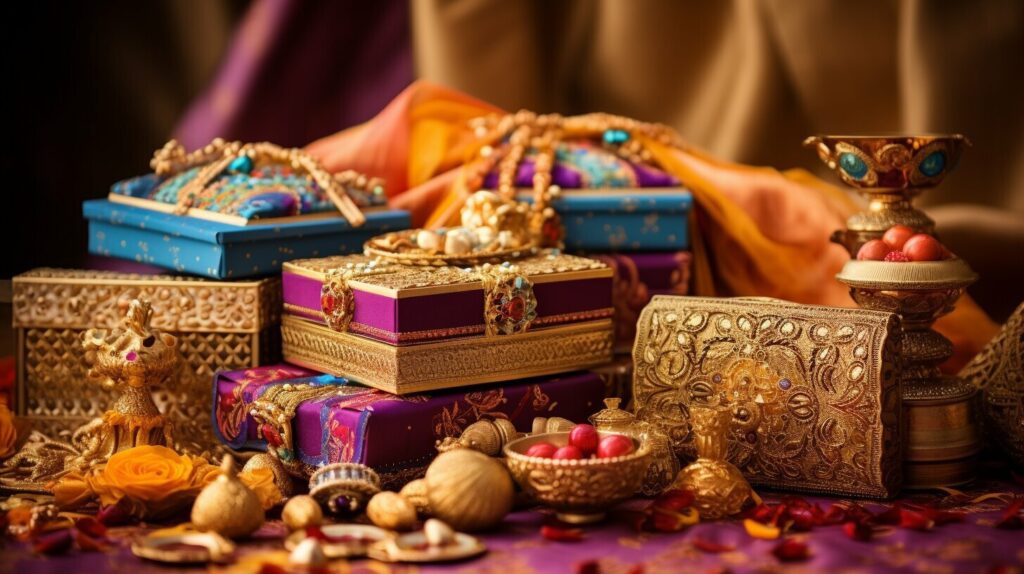Welcome to the magical world of Indian weddings, where vibrant colours, rich traditions, and everlasting bonds come together in a joyous celebration. From the intricate ceremonies to the exquisite attire, every aspect of an Indian wedding is designed to create an unforgettable experience that symbolizes the union of two souls and the merging of families.
Key Takeaways:
- Indian weddings are a blend of rituals and mini ceremonies leading up to the main ceremony day.
- Understanding the origins and significance of Hindu wedding traditions adds depth to the celebration.
- Indian weddings are diverse, reflecting the customs and traditions of different regions and cultures.
- Incorporating traditional customs and attires adds meaning and authenticity to the wedding.
- Indian weddings are known for their vibrant attire, beautiful decorations, and delicious cuisine.
The Origin and Significance of Hindu Wedding Traditions
Hindu wedding traditions have a deep-rooted origin and hold significant meaning. Each element in a Hindu marriage celebration has its own story and importance. These traditions and rituals are meant to symbolize the physical, spiritual, and emotional union of the couple, as well as the coming together of their families through prayer and celebration. Understanding the origins of these traditions can help us appreciate the depth and beauty of our wedding ceremony.
One of the most important rituals in a Hindu wedding is the exchange of garlands, known as the Jaimala ceremony. This ritual signifies acceptance and respect between the couple and their families. The sacred fire, or Agni, is another significant aspect of the wedding ceremony. The couple takes seven steps, known as the Saptapadi, around the fire, making vows to each other for a lifelong commitment. These rituals have been passed down through generations, connecting us to our rich cultural heritage.
“The beauty of Hindu wedding traditions lies in their ability to bring together families and create a strong bond between the couple.”
The elaborate decorations and vibrant colors are also an integral part of Hindu weddings. The mandap, a canopy under which the wedding ceremony takes place, is adorned with flowers and fabrics, creating a sacred and beautiful space. The bride, dressed in a traditional saree or lehenga, is adorned with intricate jewelry and henna designs. The groom also wears traditional attire, complete with a turban and accessories. The combination of these elements adds to the visual splendor and cultural richness of the wedding celebration.
Hindu wedding traditions have withstood the test of time, carrying forward the values and beliefs of our ancestors. By embracing these traditions, we honor our cultural heritage and create a wedding celebration that is filled with love, joy, and meaningful rituals.
The Origin and Significance of Hindu Wedding Traditions
| Tradition | Origin | Significance |
|---|---|---|
| Exchange of Garlands | Symbolic of acceptance and respect | Strengthens the bond between the couple and their families |
| Saptapadi (Seven Steps) | Ancient Vedic ritual | Represents the seven sacred vows taken by the couple |
| Agni (Sacred Fire) | Symbol of purity and divine witness | Represents the presence of God and the eternal flame of love |
| Mandap Decorations | Traditional practice | Creates a sacred and beautiful atmosphere for the ceremony |
| Bridal Attire | Traditional garments | Reflects the cultural identity of the bride and adds to the visual splendor |
Embracing Diversity in Indian Weddings
Indian weddings are a celebration of love, tradition, and cultural diversity. With over 30 distinct cultures within the South Asian region, each Indian wedding is a unique reflection of the couple’s heritage and customs. Embracing this diversity allows for a more authentic and personalized wedding experience, incorporating cultural nuances that make the celebration truly special.
Whether it’s a North Indian, South Indian, Punjabi, or any other regional wedding, understanding and respecting the cultural traditions specific to each family is essential. From the pre-wedding rituals to the main ceremony, every aspect of the wedding showcases the rich tapestry of Indian culture. Embracing and appreciating these cultural nuances not only enhances the wedding experience but also fosters a deeper understanding and connection between families.
One of the most beautiful aspects of an Indian wedding is the diverse range of customs and traditions that are woven into the celebration. From the Mehndi ceremony to the Baraat procession, each tradition carries its own significance and adds a unique touch to the wedding festivities. By incorporating these customs into the wedding, couples can honor their heritage and create lasting memories for themselves and their guests.
Table: Comparison of Customs in Different Indian Weddings
| Region | Customs | Significance |
|---|---|---|
| North India | Mehndi ceremony | Auspicious application of henna on the bride’s hands and feet |
| South India | Thali Kettu | Tying a sacred thread around the bride’s neck as a symbol of marriage |
| Punjab | Anand Karaj | The Sikh wedding ceremony that signifies the union of two souls |
“An Indian wedding is a tapestry of vibrant colors and rich traditions, woven together to create a celebration like no other.” – Unknown
By embracing the diversity of Indian weddings, couples can create an enchanting and inclusive atmosphere for their guests. From the choice of attire to the selection of music and cuisine, incorporating elements from different cultural backgrounds adds depth and meaning to the wedding experience. It is a celebration that brings people together, regardless of their cultural heritage, fostering a sense of unity and joy.
So, let us celebrate the beauty of diversity in Indian weddings and honor the customs and traditions that make each celebration unique. By embracing the cultural nuances and customs specific to different Indian families, we can create a truly unforgettable wedding experience that reflects the vibrant tapestry of Indian culture.
Incorporating Traditional Customs into Your Indian Wedding
When planning an Indian wedding, it is essential to embrace and incorporate the rich customs and traditions that have been passed down through generations. These traditional Indian wedding customs add a sense of meaning, depth, and cultural significance to the celebration. From the Saptapadi, which symbolizes the seven vows of marriage, to the Kanya Daan, where the bride’s parents give her away, each ritual holds its own significance and contributes to the overall beauty of the ceremony.
To truly honor your heritage and create a memorable wedding experience, consider incorporating customs such as the Haldi ceremony, where a paste made from turmeric, oil, and water is applied to both the bride and groom’s skin to bless them with a radiant glow. Another popular custom is the Mehndi ceremony, where intricate henna designs are applied to the bride’s hands and feet, symbolizing beauty, love, and auspiciousness.
To give your guests a deeper understanding of the customs and rituals involved, consider providing a detailed program that explains each step of the ceremony. This will not only enhance their experience but also allow them to fully appreciate the significance of the traditions being followed. By incorporating these customs into your Indian wedding, you create a celebration that is steeped in tradition, bringing together the past, present, and future in a beautiful union of love and culture.
| Custom | Significance |
|---|---|
| Saptapadi | The seven vows of marriage, symbolizing unity, love, and commitment. |
| Kanya Daan | The giving away of the bride by her parents, symbolizing their blessings and acceptance of the groom into their family. |
| Haldi Ceremony | Applying a turmeric paste to the couple’s skin for luck, prosperity, and a radiant complexion. |
| Mehndi Ceremony | Applying henna designs to the bride’s hands and feet, symbolizing beauty, love, and auspiciousness. |
“Incorporating traditional customs into our Indian wedding allowed us to honor our heritage and create a celebration that was truly meaningful and culturally rich. From the mesmerizing Saptapadi to the vibrant colors of the Haldi ceremony, each ritual added a unique touch to our special day. We provided our guests with a detailed program, ensuring they understood the significance behind each tradition. Our wedding was a beautiful blend of love, culture, and tradition that will be cherished forever.”
The Beauty of Indian Wedding Attire
When it comes to Indian weddings, one can’t help but be captivated by the beauty of the attire. The elaborate outfits worn by the bride and groom, as well as their guests, are a visual feast that adds to the vibrant atmosphere of the celebration. In an Indian wedding, the bride typically adorns a lehenga or sari, while the groom opts for a kurta or sherwani. These traditional garments are known for their intricate detailing, luxurious fabrics, and exquisite craftsmanship.
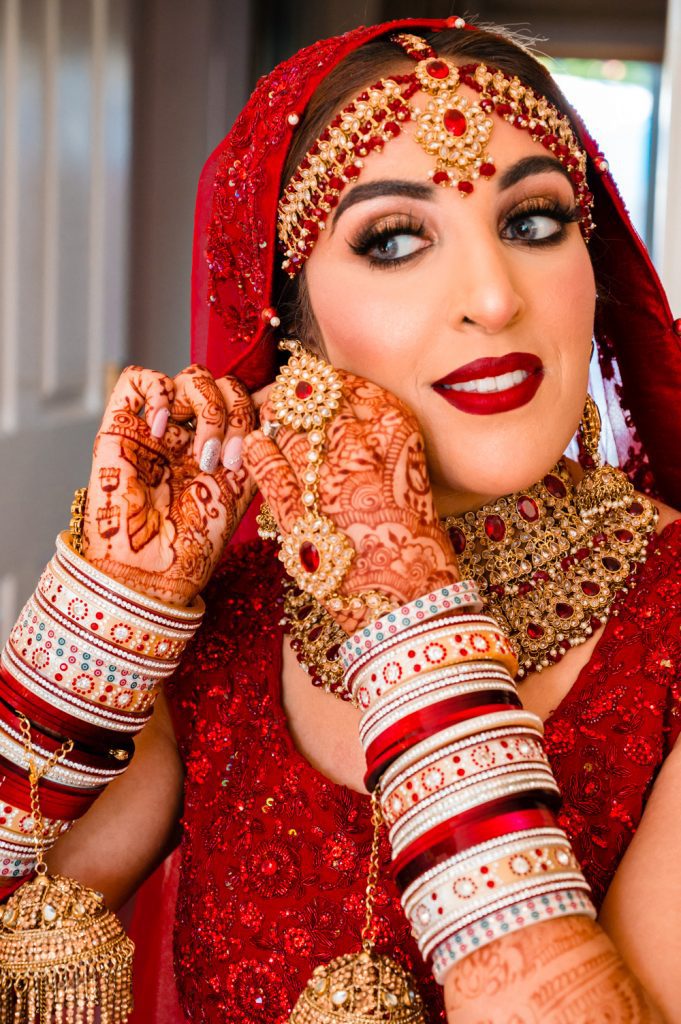
Indian wedding attire
For the Indian bride, the choice of attire is a reflection of her cultural heritage and personal style. The lehenga, a skirt paired with a blouse and a dupatta (scarf), is often embellished with intricate embroidery, sequins, and beads. The sari, a draped garment, is equally stunning, with its flowing fabric and elegant draping styles. The bride’s attire is usually complemented by elaborate jewelry, including necklaces, earrings, and bangles, adding to the overall regal look.
The Indian groom’s attire is equally important, showcasing his sense of style and tradition. The kurta, a long tunic, is often paired with a churidar (fitted trousers) or dhoti (a draped garment). The sherwani, a heavily embroidered coat, is another popular choice, bringing an air of sophistication and grandeur to the groom’s ensemble. Paired with a turban or safa, the groom’s attire completes his distinguished look.
Indian Wedding Attire Tips:
- For guests attending an Indian wedding, it is appropriate to wear traditional Indian attire or formal Western attire if traditional garb is not available.
- Women can opt for a saree, lehenga, or salwar kameez, while men can choose a kurta pajama or a formal suit.
- It is advisable to stick to vibrant colors and avoid wearing white or black, as these colors are traditionally associated with mourning in Indian culture.
- Don’t forget to accessorize your outfit with statement jewelry, such as earrings, bangles, or a tikka (headpiece).
“The beauty of Indian wedding attire lies in its ability to showcase the rich cultural heritage and craftsmanship of our traditions. The intricate details, vibrant colors, and luxurious fabrics all come together to create a visual spectacle that is truly awe-inspiring.”
Indian wedding attire is not just about clothing; it’s a celebration of art, culture, and tradition. From the bride and groom to the guests, everyone plays a part in creating a visually stunning celebration. Embracing the beauty of Indian wedding attire allows us to immerse ourselves in the rich tapestry of Indian culture and experience the true essence of this joyous occasion.
Creating a Vibrant Indian Wedding Decor
Indian weddings are known for their vibrant and visually stunning decorations. The use of rich color palettes and ornate designs creates an atmosphere of celebration and joy. From the entrance gate to the mandap (wedding altar) and reception area, every corner is adorned with intricate details that reflect the cultural heritage of the couple.
One of the key elements of Indian wedding decor is the vibrant color palette. Prismatic shades of red, orange, and pink are commonly used to symbolize joy, love, and prosperity. These colors are incorporated into various aspects of the decor, including flower arrangements, draperies, and table settings. The use of gold accents adds a touch of opulence and elegance to the overall aesthetic.
Incorporating Traditional Elements
To create an authentic and vibrant Indian wedding decor, it is important to incorporate traditional elements. Statues and images of the goddess Ganesha, known as the Lord of Beginnings and the Remover of Obstacles, are often displayed as a symbol of blessings and prosperity. Floral garlands made of marigolds, jasmine, and roses are commonly used to adorn the venue and create a fragrant and visually pleasing ambiance.
Table settings play a significant role in Indian wedding decor. The use of colorful tablecloths, intricate centerpieces, and traditional silverware adds elegance and charm to the dining area. It is common to see a mix of Indian and Western-inspired table settings, combining traditional elements with modern aesthetics.
Creating a vibrant Indian wedding decor requires attention to detail and a deep appreciation for the cultural significance of each element. By embracing the rich colors, traditional elements, and intricate designs, couples can create a visually stunning ambiance that immerses guests in the beauty and joy of Indian culture.
Indulging in the Flavors of Indian Wedding Food
One of the highlights of attending an Indian wedding is undoubtedly the delicious and flavorful cuisine. The Indian wedding menu is a feast for the senses, offering a wide variety of dishes that cater to different tastes and preferences. From aromatic curries to mouthwatering biryanis, the food at an Indian wedding is sure to leave a lasting impression on guests.
The traditional Indian wedding menu is known for its diverse range of flavors and spices. Popular dishes include butter chicken, lamb korma, and vegetable biryani. These dishes are typically accompanied by freshly baked naan bread, fragrant rice, and an assortment of chutneys and pickles. The use of spices such as cumin, coriander, turmeric, and garam masala gives the food its distinctive taste and aroma.
Indian weddings often feature buffet-style dinners, where guests can indulge in a variety of dishes at their own pace. This allows attendees to sample a little bit of everything and discover new flavors. It is important to consider any dietary restrictions of the guests, as many Indian dishes contain ingredients like dairy, nuts, and gluten. Providing a range of vegetarian and vegan options ensures that everyone can enjoy the culinary delights of an Indian wedding.
| Dish | Description |
|---|---|
| Butter Chicken | A creamy and flavorful chicken curry made with tomato, butter, and a blend of spices. |
| Vegetable Biryani | A fragrant rice dish cooked with a mix of vegetables and aromatic spices. |
| Gulab Jamun | Deep-fried milk dumplings soaked in a sweet syrup, served as a popular dessert. |
| Mango Lassi | A refreshing yogurt-based drink blended with ripe mangoes, perfect for quenching thirst. |
Indian wedding food is not only delicious but also represents the rich culinary traditions of the country. It is a celebration of regional cuisines and the flavors that have been passed down through generations. Whether you’re a fan of spicy curries or prefer milder options, the variety of dishes at an Indian wedding ensures that there is something for everyone to enjoy.
Quote:
“The food at an Indian wedding is like a symphony of flavors and spices. Each dish tells a story, reflecting the rich culinary heritage of the country. It’s a feast for the senses that brings people together, creating unforgettable memories.”
Understanding Indian Wedding Guest Etiquette
Attending an Indian wedding is a truly special experience, filled with rich traditions and cultural celebrations. As a guest, it is important to familiarize yourself with Indian wedding guest etiquette to ensure you fully appreciate and respect the significance of the occasion. Here, we will guide you through the dos and don’ts of attending an Indian wedding, from pre-wedding events to appropriate attire.
Indian Pre-Wedding Events
Indian weddings often involve a series of pre-wedding events, each with its own unique customs and significance. The Mehndi ceremony is a festive occasion where intricate henna designs are applied to the bride’s hands and feet. The Sangeet is a lively musical evening filled with dance performances and joyous celebrations. The Haldi ceremony involves the application of turmeric paste to the bride and groom as a beautification and purification ritual. As a guest, you may be invited to one or more of these events, so it is important to RSVP and attend with enthusiasm and respect for the customs being observed.
Indian Wedding Dress Code
When it comes to attire, Indian weddings are known for their vibrant colors and elaborate outfits. As a guest, you have the option to embrace traditional Indian attire, such as a saree for women or a kurta for men. If you prefer, you can also opt for formal Western attire. It is always best to check with the couple or their families if there is a specific dress code mentioned on the invitation. Additionally, it is customary to avoid wearing black or white, as these colors are traditionally associated with mourning in Indian culture.
| DOs | DON’Ts |
|---|---|
|
|
“Attending an Indian wedding is a beautiful opportunity to embrace a different culture and celebrate love. By observing the customs and traditions with respect and enthusiasm, you can truly immerse yourself in the joyous atmosphere of the occasion.” – Indian Wedding Attendant
As a guest, it is important to be respectful and mindful of the rituals and traditions taking place during the wedding ceremony. Whether it’s the exchange of garlands, the lighting of the sacred fire, or the recitation of mantras, these moments hold deep significance for the couple and their families. Avoid talking loudly, taking photos or videos without permission, or causing any unnecessary distractions.
By understanding and adhering to Indian wedding guest etiquette, you can fully embrace the vibrant culture and traditions that make these celebrations so special. Remember, it’s not just a wedding, it’s an opportunity to create lasting memories and connections. So go ahead, dance to the beat of the dhol and savor the delectable flavors of Indian cuisine, as you join in the celebration of love and unity.
Exploring the Role of Religion in Indian Weddings
The vibrant and culturally rich celebration of an Indian wedding is deeply intertwined with religious traditions. Hinduism is the most practiced religion in India, and it plays a significant role in shaping the rituals and customs of Indian weddings. From the moment the couple decides to tie the knot, religious ceremonies and prayers form an integral part of the wedding journey.
For Hindu weddings, the religious ceremonies begin with the engagement ceremony, known as the Sagai or the Ring Ceremony. This is followed by pre-wedding rituals such as the Mehndi ceremony, where intricate henna designs are applied to the bride’s hands and feet, and the Haldi ceremony, where a turmeric paste is applied to the couple’s bodies for purification.
On the day of the wedding, the main religious ceremony takes place, typically in front of a sacred fire. This ceremony, known as the Vivaah Sanskar, involves the bride and groom taking seven vows, known as the Saptapadi, to symbolize their commitment to each other. The couple also exchanges garlands and walks around the sacred fire, signifying their eternal union.
“Religion plays a significant role in most Indian weddings, whether it’s Hinduism, Sikh traditions, or other religious beliefs. Understanding the religious aspects of the wedding ceremony can help guests appreciate the cultural significance and follow along with the rituals.”
In Sikh weddings, which are also common in India, the Anand Karaj ceremony is performed. This spiritual ceremony takes place in a Gurdwara, a Sikh place of worship, and involves the recitation of hymns, known as Shabads. The couple takes four rounds around the Guru Granth Sahib, the Sikh holy book, to signify their commitment to the principles of Sikhism and to seek blessings for their marriage.
Religious customs and traditions not only add depth and meaning to Indian weddings but also serve as a way to connect the couple with their cultural heritage. Whether it’s Hinduism, Sikh traditions, or another religious belief, these ceremonies create a sense of unity, spirituality, and eternal love that forms the foundation of an Indian wedding.
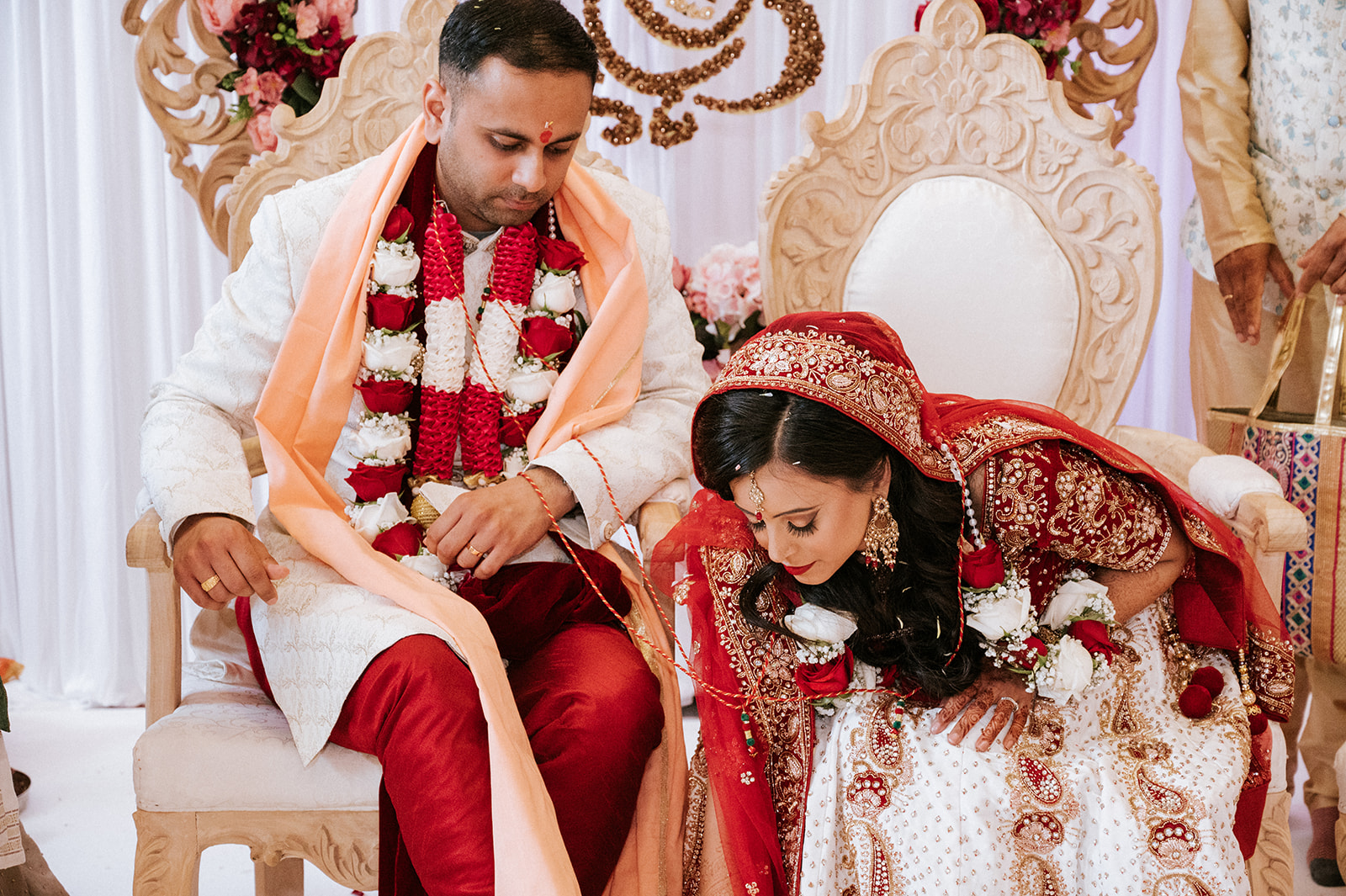
religion in Indian weddings
| Religion | Main Religious Ceremony | Key Rituals |
|---|---|---|
| Hinduism | Vivaah Sanskar | Saptapadi, garland exchange, walking around the sacred fire |
| Sikhism | Anand Karaj | Recitation of Shabads, four rounds around the Guru Granth Sahib |
In conclusion, religion holds a significant place in Indian weddings. Whether it is Hinduism, Sikh traditions, or other religious beliefs, these ceremonies and rituals reflect the devotion, spirituality, and cultural heritage of the couple. Embracing the religious aspects of an Indian wedding allows guests to appreciate the depth of the traditions and the eternal bond being formed between the couple.
Gifts and Gestures at Indian Weddings
Gift-giving is an integral part of Indian weddings, allowing guests to convey their best wishes and blessings to the newly married couple. In Indian wedding gift traditions, it is customary to offer monetary gifts, symbolizing prosperity and good fortune for the couple’s future. The most common way to present money at an Indian wedding is in a customized paper envelope known as Paiso Ka Lifafa. This envelope is often adorned with intricate designs and patterns, adding a touch of elegance to the gesture.
Another popular Indian wedding gift idea is silver items, which are considered auspicious and are believed to bring blessings and prosperity to the couple. Whether it’s a silver coin, a set of silver utensils, or a traditional silver piece of jewelry, these gifts hold sentimental value and are cherished by the couple. Additionally, dried fruit in a silver box is a symbol of good health and would be a thoughtful and appropriate choice as well.
When selecting a gift for an Indian wedding, it is important to consider the couple’s cultural traditions and customs. It is common for couples to provide a wedding registry or share their preferences with close family and friends, making it easier for guests to choose a meaningful and useful gift. However, if a registry is not available, it is always thoughtful to opt for something that aligns with the couple’s interests or can be cherished as a keepsake in their new journey together.
| Gift Ideas | Meaning |
|---|---|
| Dried fruit in a silver box | A symbol of good health |
| Customized paper envelope (Paiso Ka Lifafa) | Bringing prosperity and good fortune |
| Silver items (coin, utensils, jewelry) | Auspicious and symbolize blessings and prosperity |
Conclusion
Gift-giving at Indian weddings is not only a gesture of love and affection but also an opportunity to honor the couple’s heritage and celebrate their union. By selecting gifts that hold cultural significance and meaning, guests can contribute to the joyous occasion and create lasting memories for the couple. Whether it’s a thoughtful monetary gift or a cherished silver item, the act of giving becomes a symbol of well wishes and blessings for their new journey together.
Conclusion
An Indian wedding is a magical celebration filled with vibrant colours, timeless traditions, and overwhelming love. By embracing the rich cultural heritage and diversity of Indian weddings, couples can create a truly unforgettable experience for themselves and their loved ones.
From the intricate rituals and customs to the elaborate attire and decor, every aspect of an Indian wedding is designed to celebrate the union of two souls and the coming together of families in a joyous celebration. The deep-rooted traditions and rituals symbolize the physical, spiritual, and emotional union of the couple, while the diverse cultural nuances allow for a more authentic and personalized wedding experience.
Whether it is incorporating traditional customs, indulging in the flavors of Indian wedding food, or understanding guest etiquette, an Indian wedding offers a rich and immersive experience that showcases the beauty of Indian culture. It is a celebration that brings people together, strengthens familial bonds, and creates memories that will be cherished for a lifetime.
So, as you embark on your Indian wedding journey, immerse yourself in the vibrant colours, embrace the traditions, and enjoy the overwhelming love that surrounds you. It is a celebration like no other, and it will truly be an unforgettable experience.
FAQ
What are some common Hindu wedding traditions?
Hindu wedding traditions include rituals such as the Saptapadi (seven steps), Kanya Daan (giving away of the bride), and the exchange of garlands.
How do Indian weddings differ based on region?
Indian weddings vary based on region, with different customs and traditions specific to North Indian, South Indian, Punjabi, and other regional cultures.
What should guests wear to an Indian wedding?
Guests can wear traditional Indian attire, such as a lehenga or sherwani, or opt for formal Western attire if traditional Indian garb is not available.
What types of decorations are common at Indian weddings?
Indian weddings feature vibrant color palettes and ornate designs, often incorporating shades of red, orange, and pink, as well as statues of the goddess Ganesha for blessings and prosperity.
What kind of food is served at Indian weddings?
Indian weddings typically offer a buffet-style dinner with a variety of dishes, including rice, naan, chicken dishes, and lentil dishes.
What should guests know about Indian wedding etiquette?
Guests should be aware of pre-wedding events, dress appropriately, and be respectful of rituals and traditions during the ceremony.
What role does religion play in Indian weddings?
Hinduism is the most practised religion in India and is commonly observed in Indian weddings, although other couples may choose to incorporate Sikh traditions or have a secular ceremony.
What are some traditional Indian wedding gifts?
Traditional Indian wedding gifts include money in a customized paper envelope called Paiso Ka Lifafa or silver gifts symbolizing good fortune.
